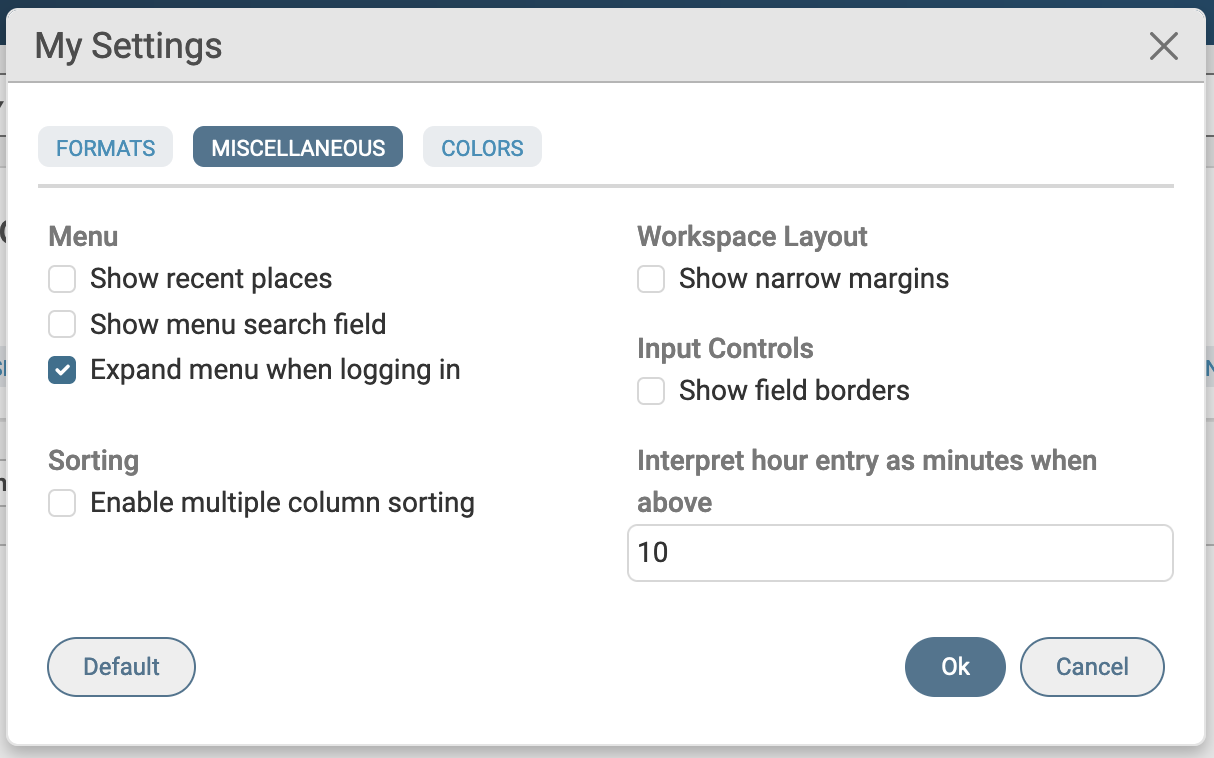Change Default Settings
The end-user can configure language, formatting, and other user interface settings through the My Settings dialog box. This dialog box can be accessed by clicking the avatar icon at the top-right corner of the web client, as shown in the following screenshot.
The My Settings dialog box has two tabs:
- The Formats & Language tab covers data formatting and language options.
- The Miscellaneous tab covers various minor user interface features that you can reconfigure.
- The colors tab covers selection of color scheme.

As a system administrator, you can push global defaults for some of these settings or, in some cases, disable the end-user's ability to override these defaults. This guide describes the nature of and configuration options for each setting.
End-user changes to the default settings are stored in the database for each user. If the same user logs in to the system on another device, the stored settings are applied. The end-user can revert to the default settings by clicking the Default action. It is currently not possible for an administrator to clear end-user settings or push new settings that override the end-user's choices.
Formats
The Formats tab shown in the following screenshot supports end-user configuration of certain localization features. This section describes each of these features.

Language
The language setting determines the end-user language that all labels and titles are translated to as well as the country from which regional settings are derived. Each available language corresponds to a Maconomy dictionary installed in the Definitionsfolder on the server. It is possible to add new dictionaries to the Maconomy server and make them available in the Web Client by adding them to the Definitions folder.
Dictionaries use locale names that consist of a language part, a country and optionally a variant part. British English and US English are for instance en_GB and en_USrespectively. The third component, the variant part, can be used for dialects or company-specific translations, e.g., fr_FR_CPA for the French dictionary for certified public accountants (CPA).
It is possible to configure a global default language for all users via the preferred property in the Language.json file. This will take effect as long as the individual end-user has not made an explicit language selection either on the login page or in the My Settings window. Once an end-user makes a language selection, that language selection will be stored in the database. It is not possible for an administrator to clear or override that selection.
It is also possible to remove the option to select a language both on the login screen and in the My Settings window. This can be achieved by the administrator with JSON configuration, specifically in the file Language.json in the fixed property. In this case, the language for all users will be set to the value of the preferred property. In the code excerpt below, the installation has been configured to not have the language selection option and all users are forced to use Italian.
{
"preferred": "it_IT",
"fixed": true
}
Region
The region setting determines the end-user region and indirectly the default regional settings used to format data. Previous versions of the web client derived the region from the end-user's language, i.e., locale. From Maconomy 2.6.3, the language and region are split into different properties to allow end-users to select a non-default language despite their region, e.g., using the English language while using Swedish date, time and number format.
It is possible to configure a global default region for all users via the preferred property in the Language.json file. This will take effect as long as the individual end-user has not made an explicit region selection either on the login page or in the My Settings window. Once an end-user makes a region selection, that region selection will be stored in the database. It is not possible for an administrator to clear or override that selection.
It is also possible to remove the option to select a region both on the login screen and in the My Settings window. This can be achieved by the administrator with JSON configuration, specifically in the file Language.json in the fixed property. In this case, the region for all users will be set to the value of the preferred property. In the code excerpt below, the installation has been configured to not have the region selection option and all users are forced to use Sweden as their region (while speaking US English).
{
"preferred": {
"language": "en_US",
"region": "SE"
},
"fixed": true
}
Date Format
The date format option determines how date objects received from the server are rendered as strings. The formatting is controlled by a format string that follows the Kendo-Intl specification.
It is not possible for an administrator to define a default date format. The default format for an individual end-user will be derived from the regional settings from the end-user's browser.
Time Format
The time format option determines how time objects received from the server are rendered as strings. The formatting is controlled by a format string that follows the Kendo-Intl specification.
It is not possible for an administrator to define a default time format. The default format for an individual end-user will be derived from the regional settings from the end-user's browser.
Number Format
The number format setting determines the decimal symbol and the digit grouping symbol used to format numbers. The decimal symbol determines the symbol used to separate the whole number part and the fractional part of real and amount values received from the server. The digit grouping symbol determines the symbol used to group the whole number part of integer, real and amount values received from the server.
It is not possible for an administrator to define a default number format. The default format for an individual end-user will be derived from the regional settings from the end-user's browser.
Number of Decimals
The Number of decimals option determines the number of decimals to show for real values received from the server. The default number is 2 decimals. The setting applies globally.
It is also possible for an administrator to globally control the number of decimals via JSON configuration, specifically in the file settings.json in the decimalPlaces property. In the code excerpt below, the default number of decimals is changed to 5.
{
"formatting": {
"real": {
"decimalPlaces": 5
}
If the end-user makes a non-default selection of number of decimals in the My Settings window, that choice will take effect rather than the global default configured in JSON.
Preview
The Preview pane shows a preview of how the selected language, region and formats will impact data rendered in the user interface.
Miscellaneous
The Miscellaneous tab shown in the screenshot below supports end-user configuration of certain user interface features. In this section, we will describe what each of these features are.

Menu
The following three settings can be used to configure the appearance of the sidebar menu.
Recent Places
The Show recent places checkbox determines if the menu should include a menu group showing the last couple of visited workspaces. This feature is useful for workflows where the end-user has to quickly jump back and forth between a small number of workspaces. It is disabled by default and changes to this setting cannot be pushed by an administrator via JSON configuration.
Search
The Show menu search field checkbox determines if a search field should be rendered in the top of the menu. The search fields allows the user to quickly find a workspace by typing in part of ts name. It is disabled by default.
It is possible for an administrator to change the default value via JSON configuration, specifically in the file settings.json in the search property. If the end-user has enabled menu search, the global default will be ignored. In the code excerpt below, the global default has been changed to enable the menu search by default.
{
"menu": {
"search": false,
...
},
Expand/Collapse
The Expand menu when logging in checkbox determines whether the web client opens with the menu expanded or collapsed upon login. It is enabled by default.
It is possible for an administrator to change the default value via JSON configuration, specifically in the file settings.json in the expanded property. If the end-user has decided to collapse the menu by default, the global default will be ignored. In the code excerpt below, the global default has been changed to collapse the menu by default.
"menu": {
...
"expanded": false
},
Sorting
The enabled multiple column sorting checkbox determines if it is possible to sort on more than one column in tables and list views. It is disabled by default and changes to this setting cannot be pushed by an administrator via JSON configuration.
Workspace Layout
The show narrow margins checkbox determines if the content in the workspace area should grab all horizontal space or leave a certain margin. The default value is to leave a certain margin to avoid that layout content such as for instance card fields are placed to far apart. The end-user can change this default by checking the checkbox.
It is also possible for an administrator to push a global default via JSON configuration, specifically in the file settings.json in the grabHorizontalSpace property. In the code excerpt below, the global default value is changed such that only narrow margins are shown.
{
...
"layout": {
"grabHorizontalSpace": true
}
Input Controls
The show field borders checkbox determines if editable form fields are rendered with a visible border even when they are not focused or updated. It is disabled by default and changes to this setting cannot be pushed by an administrator via JSON configuration.
Interpret Hour Entry as Minutes When Above
The Interpret hour entry as minutes when above setting determines the threshold value for time duration entry. This threshold determines when the entered number should be treated as a number of hours or minutes. When the entered value is above the threshold, it will be treated as a value with the minutes unit. Otherwise, it will be treated as a number of hours.
It is possible for an administrator to change the default value via JSON configuration, specifically in the file settings.json in the minutesThreshold property. The default is 10. In the code excerpt below, the default threshold has been changed to 20.
{
"minutesThreshold": 20,
...
Colors
The colors tab shown in the screenshot below allows the end-user to select a different color scheme. Currently, only the light theme is production ready. The dark theme is still in beta. The auto option will use the default of the end-user's operating system. Changes to the colors setting cannot be pushed by an administrator via JSON configuration.

